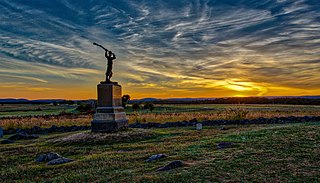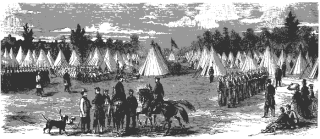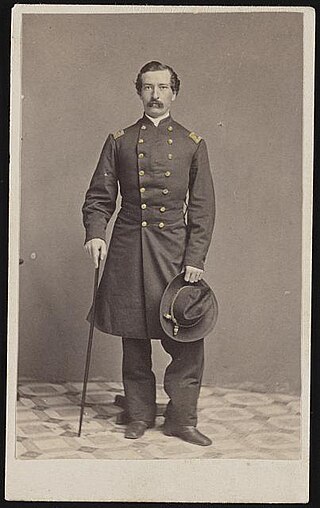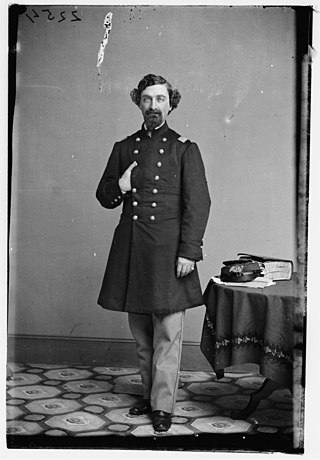
The 69th Pennsylvania Infantry was an infantry regiment in the Union army during the American Civil War.

The 72nd Pennsylvania Infantry was a volunteer infantry regiment which served in the Union Army during the American Civil War. It was part of the famous Philadelphia Brigade.
The 6th New Jersey Infantry Regiment was regiment of infantry from New Jersey that served in the Army of the Potomac during the American Civil War.

The 62nd New York Infantry Regiment was an infantry regiment that served in the Union Army during the American Civil War. It is also known as the Anderson Zouaves.

The 4th Michigan Infantry Regiment was an infantry regiment that served in the Union Army during the American Civil War. The 4th Michigan wore a very Americanized zouave uniform. This uniform consisted of a Federal dark blue 4 button sack coat, dark blue chasseur trousers, tan gaiters, and a maroon zouave fez with a light blue tassel.

The 5th Michigan Infantry Regiment was an infantry regiment from Michigan that served in the Union Army during the American Civil War. The regiment was mustered into federal service in August 1861 and served in the Eastern Theater. It fought in all the major battles of the Army of the Potomac, including Seven Pines, the Seven Days Battles, Second Bull Run, Chantilly, Antietam, Fredericksburg, Chancellorsville, Gettysburg, the Wilderness, Spotsylvania, Cold Harbor, Petersburg, and Appomattox. The regiment was mustered out in June 1865.
The 19th Regiment Illinois Volunteer Infantry was an infantry regiment that served in the Union Army during the American Civil War. Three companies formerly with Col. Elmer Ellsworth's Zouave Cadets wore a zouave uniform consisting of a dark blue zouave jacket with red trimmings, red pants, leather gaiters, a sky blue shirt, red sash, and a red French styled kepi with a dark blue band. The jacket cuffs were trimmed in yellow-orange and red. Brass buttons went down both fronts of the jacket. They were organized into four separate companies on May 4, 1861, in Chicago. It was consolidated and mustered into Federal service as the 19th Illinois Volunteer Infantry on June 17, 1861. It was mustered out at Chicago on July 9, 1864.

The 5th New York Veteran Infantry Regiment was an Infantry Regiment that served in the Union Army during the American Civil War. The regiment was known as "Duryée‘s Zouaves." The regiment had two uniforms during its time. The first uniform consisted of a medium blue zouave jacket with red trimming, a grey shirt, a red sash with sky blue trimming, red chasseur trousers with yellow piping, a red fez with a yellow tassel, and a white turban. The second and official uniform consisted of a dark blue zouave jacket with red trimmings in the Hawkin Zouave design, a dark blue zouave vest with red trimming, baggy red trousers, a red sash with sky blue trimming,a red fez with a yellow tassel, and a white turban.

The 11th New York Infantry Regiment was an infantry regiment of the Union Army in the early years of the American Civil War. The regiment was organized in New York City in May 1861 as a Zouave regiment, known for its unusual dress and drill style, by Colonel Elmer E. Ellsworth, a personal friend of U.S. President Abraham Lincoln. Drawn from the ranks of the city's many volunteer fire companies, the unit was known alternately as the Ellsworth Zouaves, First Fire Zouaves, First Regiment New York Zouaves, and U.S. National Guards.

The 44th New York Infantry Regiment was a regiment of the Union Army during the American Civil War which was formed up in mid-1861, and mustered in on August 30, 1861. The regiment wore an americanized zouave uniform which consisted of a dark blue zouave jacket with red piping on the cuffs, dark blue trousers with a red stripe, a red zouave shirt, a dark blue forage cap, and a pair of leather gaiters. The jacket had buttons down the front of it which was not part of the original French zouave uniform.

The 9th New York Infantry Regiment was an infantry regiment that served in the Union Army during the American Civil War. It was also known as the "Hawkins' Zouaves" or the "New York Zouaves."
Edward Jardine was an American U.S. Army officer during the American Civil War serving with the 9th New York Volunteer Infantry Regiment under General Benjamin Butler and later the Army of the Potomac under General Ambrose Burnside in Virginia and North Carolina campaigns. He was one of the senior military officers during the New York Draft Riots and narrowly escaped lynching at the hands of a mob. The injuries he sustained during the riots ended his military career.

William Thomas Campbell Grower was a United States Army Officer in the American Civil War, 1861 to 1865, and serving as the Major of the 17th New York Volunteer Infantry Regiment (1861–1863) and Colonel of the 17th New York Veteran Volunteer Infantry Regiment (1863–1865). He died after being fatally injured in the Battle of Jonesborough.
The 178th New York Infantry Regiment was an Infantry Regiment that served in the United States Army during the American Civil War. It was often referred to as the "Second Regiment, Hawkins Zouaves".

The 140th New York Infantry Regiment was a volunteer infantry regiment that was created on September 13, 1862, for the Union Army during the American Civil War. From January 1864 they wore a Zouave uniform.

The 2nd Regiment Massachusetts Volunteer Infantry was an infantry regiment in the Union Army during the American Civil War. Major George H. Gordon, a West Point graduate and veteran of the Mexican–American War, organized the unit's recruitment and formation. The 2nd Massachusetts was trained at Camp Andrew in West Roxbury, Massachusetts on the site of the former Transcendentalist utopian community, Brook Farm. Roughly half the regiment was mustered in on May 18, 1861 and the remainder on May 25, 1861 for a term of three years. The regiment saw extensive combat as part of the Army of the Potomac particularly during the Battle of Antietam and the Battle of Gettysburg.

The 99th New York Infantry Regiment, the "Union Coast Guard", "Bartlett's Naval Brigade", "Lincoln Divers", or "New York and Virginia Coast Guard", was organized as a naval infantry brigade, but mainly served as an infantry regiment of the Union Army during the American Civil War.

The 47th Pennsylvania Infantry Regiment, officially the 47th Regiment, Pennsylvania Volunteer Infantry and sometimes referred to simply as the 47th Pennsylvania Volunteers, was an infantry regiment that served in the Union Army during the American Civil War and the early months of the Reconstruction era. It was formed by adults and teenagers from small towns and larger metropolitan areas in central, northeastern, and southeastern regions of Pennsylvania.

The 4th Pennsylvania Infantry Regiment, officially known as the 4th Regiment, Pennsylvania Volunteer Infantry, was an infantry regiment of the Union Army in the American Civil War. Formed mostly from a militia unit in Norristown in southeastern Pennsylvania, the regiment enlisted at the beginning of the American Civil War in April 1861 for a three-month period of service under the command of Colonel John F. Hartranft. Logistical difficulties bedeviled the regiment, which served as part of the garrison of Washington, D.C., until late June, when it was sent into Northern Virginia to join in the army of Brigadier General Irvin McDowell.

The 17th New York Infantry Regiment was an infantry regiment in the Union Army during the American Civil War.











